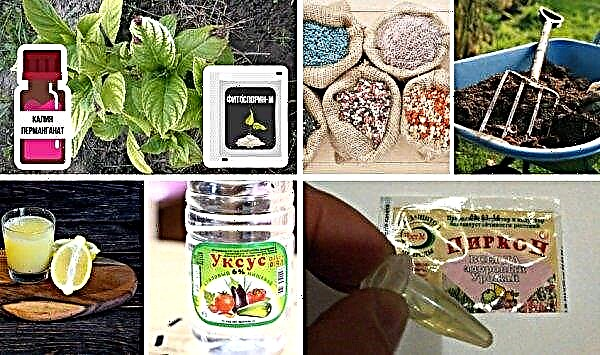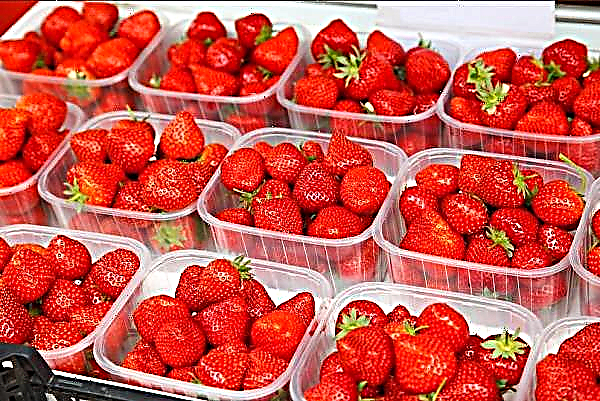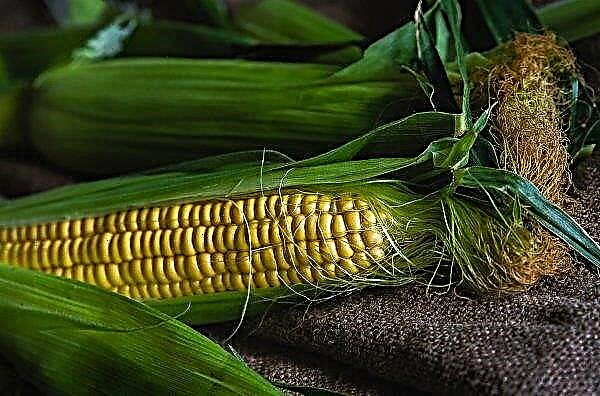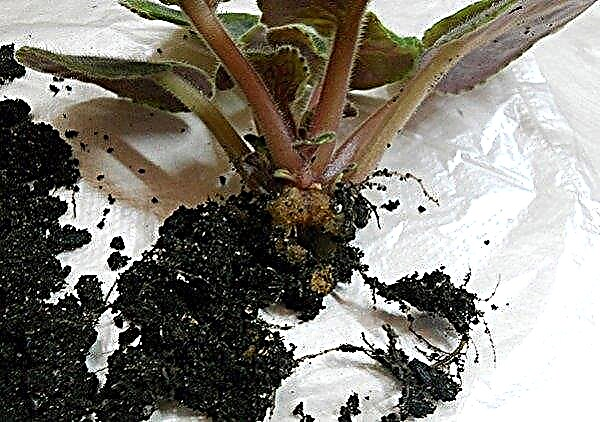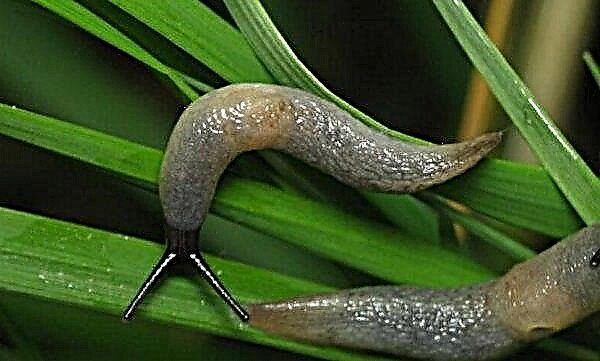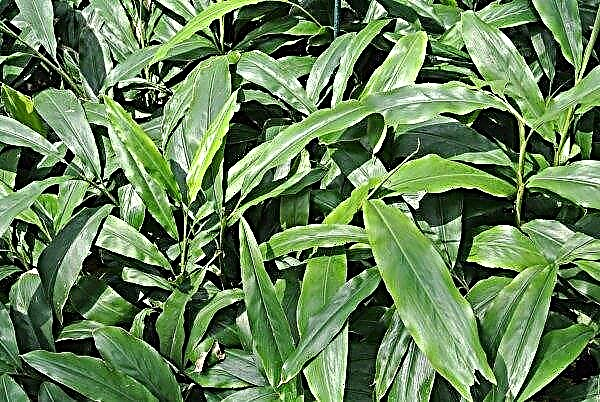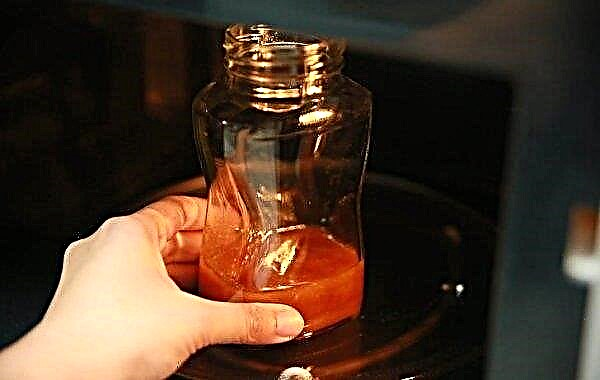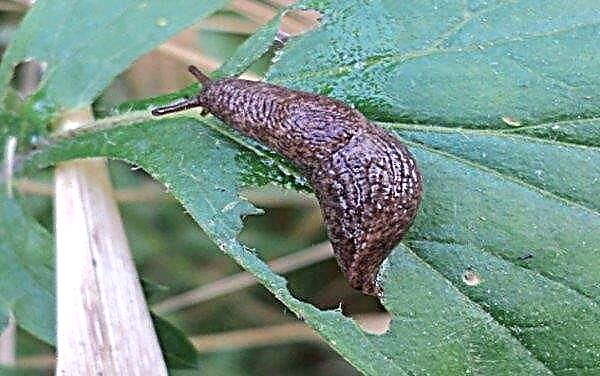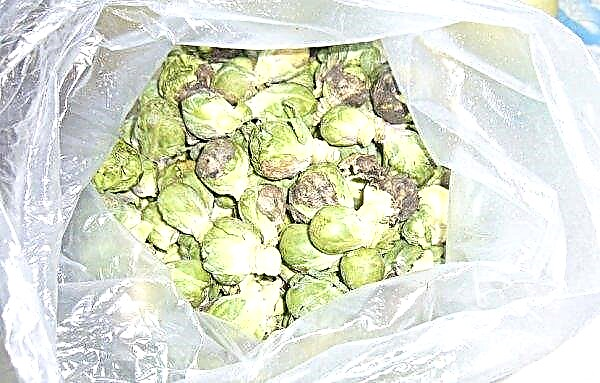In landscape design, junipers are very popular. These are winter-hardy, unpretentious and very beautiful plants that can decorate absolutely every site. In this article, we will talk about the undersized creeping juniper Repanda.
Botanical Description
This juniper is a dwarf species of this culture. A plant at the age of 10 grows up to 30 cm in height and up to 1.5 m in width. The crown diameter continues to grow from planting up to 20 years and as a result can be about 2.5 m.

Crohn consists of soft needles. Needles (5-8 mm) grow on thin shoots that are tightly located one next to the other. A feature of the Repanda variety is the color of the needles. Their outer part is covered with silver-white stripes.
In the warm season, dense needles have a green color, and in the cold they get a brown tint. The bark is gray-brown. Round cones grow on the shrub. They are small in size - up to 1 cm. Young fruits have a green color, ripened change it to a bluish-blue coating.
Did you know? If in a dream you saw juniper, then in reality you should expect wealth and good fortune.
Variety Characteristics
The main characteristics of Juniper Repanda include:
- Ephedra is a photophilous plant. Also able to grow in partial shade.
- For a year it increases in diameter by no more than 10 cm.
- The shrub is hardy and easily tolerates low temperatures up to -29 ° C.
- Variety Repanda unpretentious in the neighborhood. It can grow next to different cultures.
- Juniper easily withstands dry weather. Additional watering is necessary only for a young plant.

Landing
During landing, you must familiarize yourself with the rules of this procedure. The further growth of the bush will depend on this. After all, each plant requires an individual approach. Read on in more detail later in the article.
Landing time
Experienced gardeners recommend planting in the spring so that the plant has time to grow stronger before the onset of winter cold. If you purchased a seedling in a container, then such planting material is able to adapt more quickly to a new place. It can be planted in the autumn. The main thing is to create favorable conditions for the plant after the procedure: to provide daily watering and periodic mulching of the soil.
Site selection and site preparation
This type of juniper prefers to grow in areas open to the sun. Seating should be flat or on a hill. Flooding will adversely affect the plant. Before landing, the site must be dug up. The earth should be loose and pass oxygen and water well. A couple of days before the procedure, apply fertilizer (a complex mixture for needles) to the soil - 100 g into the planting pit.
Seedling preparation
If you want to buy a quality seedling, then you need to buy it only in trusted nurseries.
 Planting material is sold in special containers and does not require additional preparation. As a rule, in stores they are treated with all the necessary drugs.
Planting material is sold in special containers and does not require additional preparation. As a rule, in stores they are treated with all the necessary drugs.
With self-growing seedlings from cuttings or seeds before planting, its root system must be treated with a growth stimulator.
Landing rules
During planting, adhere to the following rules:
- The pit should be 2-3 times larger than the earthen lump of seedlings.
- If the soil in the area is clayey and heavy, then at the bottom of the planting hole, it is necessary to drain 20 cm thick broken brick.
- It is necessary to handle the root system very carefully, since how the bush will take up in a new place depends on this. An earthen lump on a plant is easy to damage.
- The soil mixture needed to fill the pit should consist of the following components: peat, turf land, organic matter and sand in approximately the same proportion.
- The parabolic circle should be abundantly watered with water (2 buckets) after planting and mulched with sawdust and peat (layer 8 cm).
- If you plan to plant several bushes at once, then the site should be spacious, since the permissible distance between the seedlings is at least 2 m.
 On the topsoil after planting, add some earth from under the spruce or pine. Thus, you add special microorganisms to the root system, with the help of which the plant can receive nutrients from the soil.
On the topsoil after planting, add some earth from under the spruce or pine. Thus, you add special microorganisms to the root system, with the help of which the plant can receive nutrients from the soil.
Care
This plant is unpretentious in care. Choosing the right place for planting juniper can greatly simplify all your further activities related to shrubs. The culture is very hardy and able to adapt in almost all climatic conditions. The plant requires special attention only at a young age.
Watering and feeding
After planting, the plant needs regular watering 2 times a week. Also, do not forget to spray the crown of the bush with water, after this procedure the juniper will thank you with a healthy and beautiful view. An adult plant does not need additional watering, this should only be done in dry periods in the summer.
 Repanda needs to be fertilized annually. They feed in the spring (late April - early May). To do this, you need to purchase "Kemiru-universal" or any other comprehensive nutritional product for needles in any specialized store.
Repanda needs to be fertilized annually. They feed in the spring (late April - early May). To do this, you need to purchase "Kemiru-universal" or any other comprehensive nutritional product for needles in any specialized store.
Mulching and cultivation
The soil around the young plant must be loosened several times a year (no more than 10 cm). An adult shrub will be enough only spring cultivation of the earth. Mulching is also carried out regularly in the first years after planting. Further, the plant does not need this procedure. Peat, sand, straw, fallen needles and leaves are used as the material.
Formation
It is not necessary to form the crown of this juniper variety. The shrub grows on its own and takes on a rounded squat outline. But no one canceled the sanitary pruning. Every spring, it is necessary to remove dead and damaged shoots.
Did you know? In ancient Russia, dishes were made from juniper wood. It did not spoil food for a long time and did not sour milk.
How to prepare for winter
Common juniper Repanda belongs to frost-resistant plants, therefore, it needs additional shelter only if it grows in the northern regions of our country, where the temperature often drops and keeps for a long period below -30 ° С. In this case, it is necessary to cover the roundabout circle with straw, and the crown with agrofibre. So you will be sure that the culture will remain in your garden after severe frosts.

Breeding methods
It is not difficult to propagate Juniper Repanda at home.
There are several options:
- Seed way. First you need to stratify the seed. In autumn, seeds should be sown in a box with soil. In this form, they are stored throughout the winter under the open sky and a layer of snow. In May, they can be planted in the ground to a depth of 2-3 cm. Three years later, the resulting seedling is transplanted to a permanent place.
- Cuttings. To breed a crop using this method, you need to cut lignified shoots 5–7 cm long in spring. Pay attention to the number of internodes in each segment. There should be 1–2 pcs. Next, planting material after processing the root system with a special growth stimulator is planted in a container or in a greenhouse. It is necessary to immerse the seedling no more than 2 cm. A layer of sand 3-4 cm should be poured on top. Gardeners recommend planting a young plant in a permanent place no earlier than 2 years later.
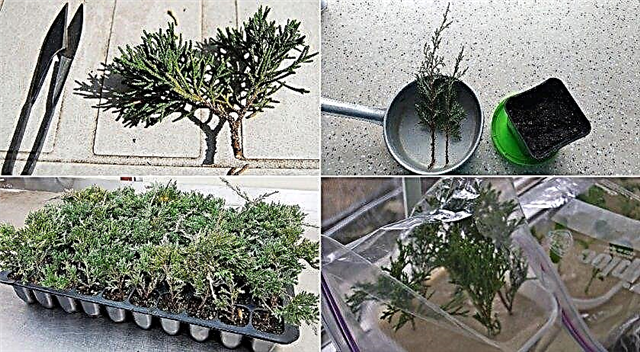
- Layering. This breeding option is most suitable for creeping juniper species. You need to choose young twigs from the bush. Peel them from needles 2 cm from the base. Each layer is pressed to the ground and during the first year it is actively watered and cared for. It should be transplanted to a permanent place when young shoots appear on this branch. You can carry out the procedure throughout the growing season.

Landscape design application
In landscape design, the shrub can perform various functions. It looks organically in rocky and heather gardens. Often this juniper is planted near the terrace. Common Repanda can grow as a single plant, and be a member of the composition among coniferous and herbaceous crops. Also, the bush is able to perform the function of a coating for the soil.
 Juniper lawns are now very popular among gardeners.
Juniper lawns are now very popular among gardeners.
Diseases and Pests
This variety is resistant to various diseases and pests.
Rarely on the shrub can you see such diseases:
- rust;
- shute;
- drying out of the branches.
 Affected branches must be removed immediately. Healthy needles should be treated with Bordeaux mixture or the drug "Skor".
Affected branches must be removed immediately. Healthy needles should be treated with Bordeaux mixture or the drug "Skor".
Among insects, a plant can affect such:
- aphid;
- scale shield;
- spider mite.
 The following drugs quickly and effectively deal with the problem: Aktara, Angio and Calypso. Inspect bushes for pests and diseases at least 1 time in two weeks. Timely determination of the disease will help you quickly deal with it.
The following drugs quickly and effectively deal with the problem: Aktara, Angio and Calypso. Inspect bushes for pests and diseases at least 1 time in two weeks. Timely determination of the disease will help you quickly deal with it.
Juniper ordinary Repanda - a wonderful plant for garden design. He will decorate the territory near the house or cottage. The shrub will delight your eyes with its elegant and interesting appearance for many years.



